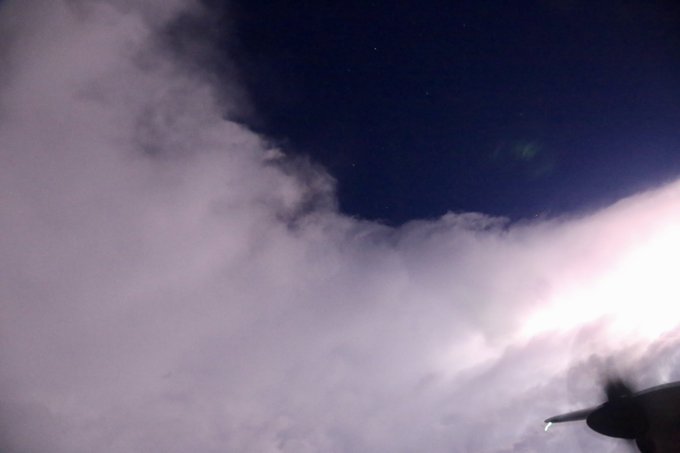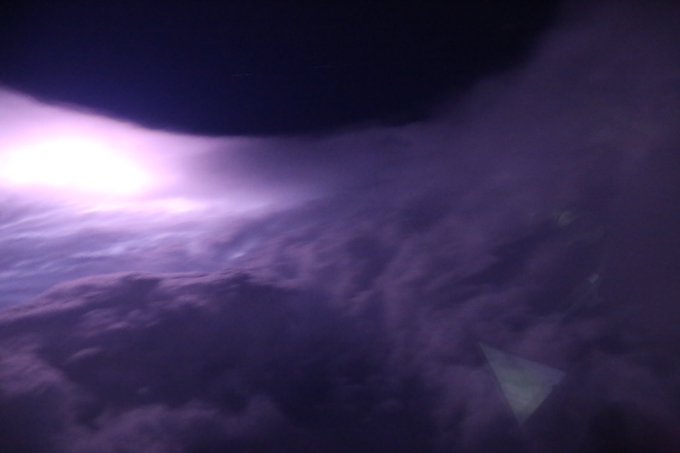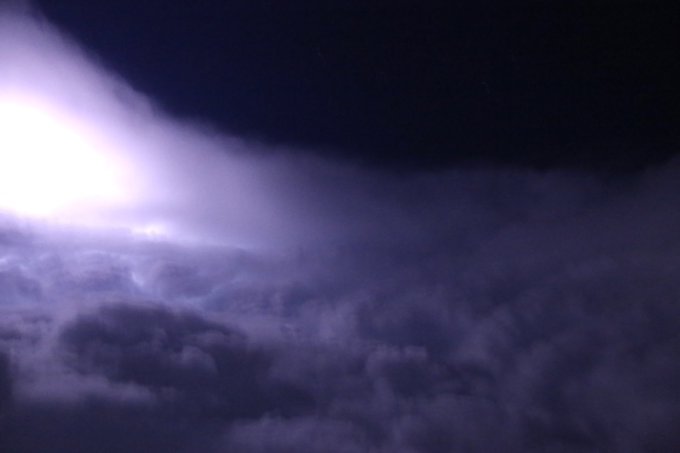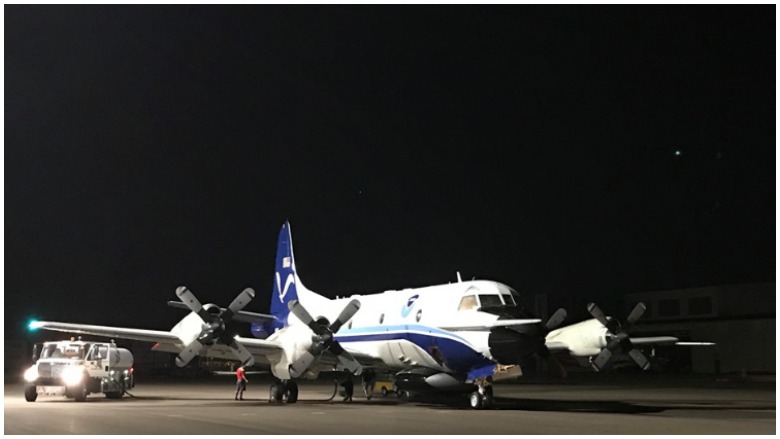
NOAA Hurricane Hunters prepare for Hurricane Dorian reconnaissance mission on Aug. 29, 2019
“Kermit” and “Miss Piggy” slice through the eyewall of a hurricane, “buffeted by howling winds, blinding rain and violent updrafts and downdrafts,” the pair enter the calm of the center of the storm, its eye. And it’s there that the twin four-engine turboprop planes flown by Air Force aviators carrying National Oceanic and Atmospheric Administration hurricane hunting scientists get to work.
The planes, two Lockheed WP-3D Orion aircraft are named for the beloved and well-known Muppets, though NOAA doesn’t really explain why. But they’re terms of endearment no doubt for the high-flying crafts; “specially equipped” meteorological stations that are key to hurricane forecasting.
The NOAA Hurricane Hunters “probe every wind and pressure change, repeating the often grueling experience again and again during the course of an 8 to 10 hour mission.”
They’re heroes, really.
Flying into Hurricane Dorian in the past few days, crews have witnessed an intensity inside a tropical cyclone that’s not been seen before. “Unprecedented,” was what the team director said.
Now based in Lakeland, Florida, atmospheric study of hurricanes from aircraft began in 1961 but it wasn’t until the creation of NOAA in 1970 that the research program really took flight and over the years, evolved into the program known today.
Studying Hurricane Dorian has been the mission for the past several days and data and photos and videos from their study are at once fascinating and frightening.
Here’s what you need to know:
1. NOAA Hurricane Hunter Team Director Says What They’ve Seen From the Eye of Hurricane Dorian Has Never Been Seen Before
In a Hurricane Hunter flight through the eye of the storm, scientists found something they have never seen before.
“Instruments on NOAA Hurricane Hunter aircraft carry instruments that measure microwave radiation off the ocean’s surface,” which provides wind speed,” director Richard Henning explained in a cable news interview.
“This morning, our aircraft began getting wind speeds that were so high that the hurricane center was doubting whether they were real.” He said when a reading of 185 MPH came in, NOAA aviators and national weather forecasters were stunned.
“These numbers that are extremely rare.” Henning said scientist dropped instrumentation “just to confirm” the readings, calling them “unprecedented.”
2. Hurricane Hunting Aviators Flying Into Dorian’s Eyewall Are Sharing Amazing Photos & Videos as They Survey the Storm
Hurricane Hunter scientists deploy GPS “dropwindsondes” as the plane flies through the hurricane. The instruments continuously transmit measurements of pressure, humidity, temperature, and wind direction and speed as they fall toward the sea, providing a detailed look at the structure of the storm and its intensity. The craft’s Doppler radar and lower fuselage radar systems, meanwhile, scan the storm vertically and horizontally, giving scientists and forecasters a real-time look at the storm.
This is how that works:
Among the many benefits of the data obtained by Hurricane Hunters is the NOAA-developed Stepped Frequency Microwave Radiometers that “measure over-ocean wind speed and rain rate in hurricanes and tropical storms, key indicators of potentially deadly storm surges. Surge is a major cause of hurricane-related deaths.”
But beyond the research, for lay people, perhaps the Hunters’ most important job is reconnaissance missions to locate the center of the storm and measure central pressure and surface winds around the eye. The U.S. Air Force Reserve’s 53rd Weather Reconnaissance Squadron also supports the mission. Information from both research and reconnaissance flights directly contribute to the safety of people living along and visiting the vulnerable Atlantic and Gulf coasts, NOAA says
3. The Number 1 FAQ for Hurricane Hunters: ‘Why Aren’t NOAA’s Hunter Planes Torn Apart in a Hurricane?’
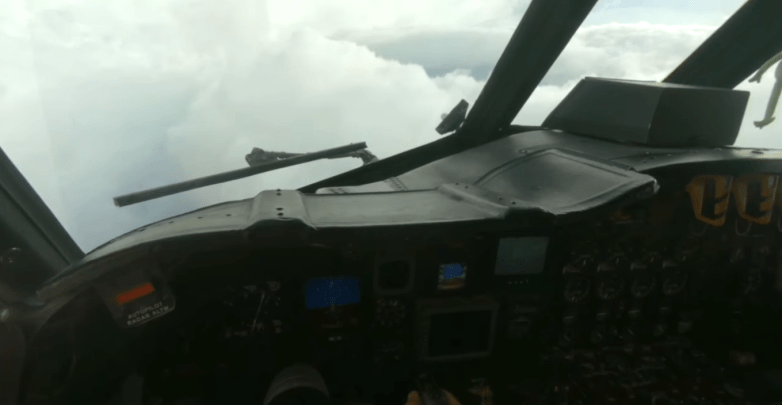
NOAAHurricane Hunters inside Dorian
NOAA has a FAQ on its Hurricane Hunters web page. But there’s just one question:
‘Why Aren’t NOAA’s Hunter Planes Torn Apart in a Hurricane?’
“Planes are generally not destroyed by strong winds while in flight. Airliners routinely fly in jet streams with winds exceeding 150 mph over the U.S. during the winter. It’s the shear, or sudden change in horizontal or vertical winds, that can destroy an aircraft, or cause its loss of control. That’s why NOAA’s Hurricane Hunter aircraft don’t fly through tornadoes. In a like manner, NOAA pilots and crew routinely (but never casually) fly in the high-wind environment of the hurricane and don’t fear it tearing the plane apart,” NOAA says.
“However, they are always monitoring for “hot spots” of severe weather and shear that they can often identify on radar and avoid if it’s too severe.
4. The Original Mission Was to ‘Modify’ Hurricanes in the ‘StormFury’ Program
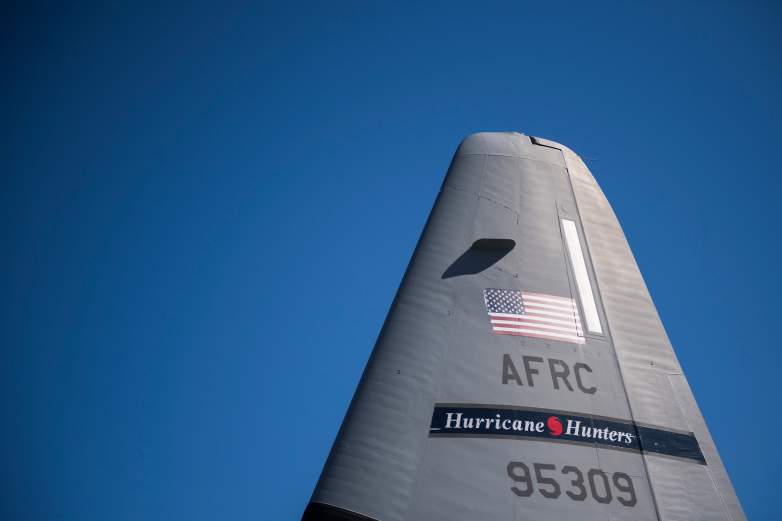
Hurricane Hunters: The tail section of a C-130 belonging to the US Air Force 53rd Weather Reconnaissance Squadron
Hurricane Hunters was originally part of the 1961 Research Flight Facility program of “atmospheric research programs which included the early attempts to modify hurricanes.” Called Stormfury, national meteorologists joined with the Department of Defense to “learn more about hurricanes to be able to say whether their intensity could be decreased through dynamic cloud seeding in order to achieve beneficial results.”
Throughout the 1960s and early 1970s, the RFF’s aircraft operating from Miami International Airport engaged in many atmospheric research projects that spanned the globe from the Arctic to India and West Africa, according to NOAA.
In 1975 it combined with the Environmental Research Laboratories and with new aircraft, the program was fully underway. Located at MacDill Air Force Base in Tampa, Florida in the early 90s, NOAA aircraft operated throughout the U.S. and around the world, “Over open ocean, mountains, coastal wetlands and Arctic pack ice.”
Overall, it’s NOAA’s mission to “describe and predict changes in the Earth’s environment and to conserve and manage wisely the nation’s coastal and marine resources. The hard-working and very specialized NOAA aircraft directly support this mission by providing scientists with unique platforms to precisely observe, measure and chart the dynamics of our oceans and our atmosphere.”
And the Hurricane Hunters are among the most celebrated.
5. So, You Can Thank Richard Milhouse Nixon In Part For Hurricane Hunters. He Created NOAA in 1970
Pres. Richard M. Nixon proposed the creation of the National Oceanic and Atmospheric Administration in July of 1970, and three months later, NOAA was born. Nixon’s goal he said at the time was to “unify the nations’ scientific efforts under one agency.”
The agency provided scientific and technical services to other federal agencies, private sector research and the American public and was tasked with the responsibility to predict changes in the oceans, atmosphere and living marine resources.


